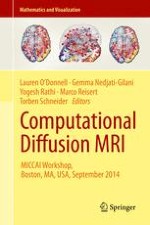This book contains papers presented at the 2014 MICCAI Workshop on Computational Diffusion MRI, CDMRI’14. Detailing new computational methods applied to diffusion magnetic resonance imaging data, it offers readers a snapshot of the current state of the art and covers a wide range of topics from fundamental theoretical work on mathematical modeling to the development and evaluation of robust algorithms and applications in neuroscientific studies and clinical practice.
Inside, readers will find information on brain network analysis, mathematical modeling for clinical applications, tissue microstructure imaging, super-resolution methods, signal reconstruction, visualization, and more. Contributions include both careful mathematical derivations and a large number of rich full-color visualizations.
Computational techniques are key to the continued success and development of diffusion MRI and to its widespread transfer into the clinic. This volume will offer a valuable starting point for anyone interested in learning computational diffusion MRI. It also offers new perspectives and insights on current research challenges for those currently in the field. The book will be of interest to researchers and practitioners in computer science, MR physics, and applied mathematics.
